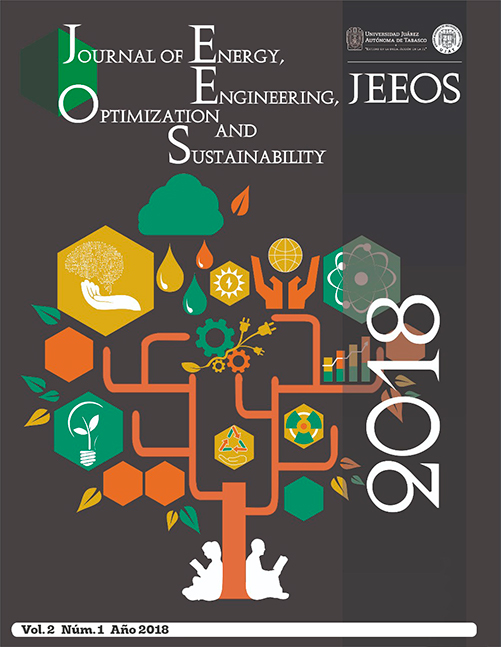CELDAS SOLARES SENSIBILIZADAS BASADAS EN ZnO CON DIFERENTES TAMAÑOS DE NANOPARTÍCULA
DOI:
https://doi.org/10.19136/jeeos.a2n1.2694Palabras clave:
Tamaños de nanopartículas, ZnO, DSSC, microondasResumen
Una manera novedosa de fabricar celdas solares sensibilizadas por colorante (DSSC) se realiza empleando diferentes tamaños de nanopartículas (NPs) de óxido de zinc (ZnO) de ~20 nm (NPs-m) y ~35 nm (NP-M), sintetizadas por la técnica de microondas asistida, mediante la modificación de distintas condiciones de operación y reacción. Las NPs- m se usaron como película activa y de transporte, mientras que las NPs-M, como película dispersora de luz. Estas configuraciones dieron como resultado que las DSSC´s con doble capa de ZnO con NPs-m y NPs-M, presenten un mejor factor de forma (FF) de 0.61 comparado con las DSSC de una capa de NPs -m. Los valores de eficiencia (?) determinados estuvieron en el rango de 2.77% a 2.11 %.Referencias
Azimah O. & Huda A. (2014). Electron transport analysis in zinc oxide-based dye-sensitized solar cells: A review. Renewable and Sustainable Energy Reviews, 31: 140-157. DOI: 10.1016/j.rser.2013.11.031
Mathew S., Yella A., Gao P., Humphry-Baker R., Curchod B. F. E., Ashari-Astani N., Tavernelli I., Rothlisberger U., Nazeeruddin M. K., Grätzel M. (2014). Dye-sensitized solar cells with 13% efficiency achieved through the molecular engineering of porphyrin sensitizers. Nature Chemistry: 242-247. DOI: :10.1038/NCHEM.1861
O'Regan B. & Grätzel M. (1991). A low-cost, high-efficiency solar cell based on dye-sensitized collodal TiO2 films. Nature, 353: 737-746.
Kumar R., Umar A., Kumar G., Singh-Nalwa H., Kumar A., Akhtar M. S. (2017). Zinc oxide nanostructure-based dye-sensitized solar cells: Review. J Mater Sci, DOI: 10.1007/s10853-016-0668-z.
Krishnapriya R. Praneetha S. & Murugan V. (2015). Energy efficient, microwave-hydro-/solvothermal synthesis of hierarchical flowers and rice-grain like ZnO nanocrystals as photoanodes for high performance dye-sensitized solar cells. CrystEngComm, 17, 8353-8367. DOI: 10.1039/C5CE01438G
Sun H., Sun L., Sugiura T., White M. S., Standler P., Sariciftci N. S., Masuhara A & Yoshida T. (2017). Microwave-assisted Hydrothermal Synthesis of Structure-controlled ZnO nanocrystals and their properties in Dye-sensitized solar cells. Electrochemistry, 85(5): 253-261. DOI:10.5796/electrochemistry .85.253
Pfau M. W., Kunzmann A., Segets D., Peukert W., Wallace G. G., Officer D. L., Clark T., Costa R. D. & Guldi M. D. (2017). Choosing the right nanoparticle size - designing novel ZnO electrode architectures for efficient Dye-Sensitized Solar Cells. J. Mater. Chem. A, 5: 7516-7522. DOI: 10.1039/C6TA11012F
Ong C. B., Ng Y. L. & Mohammad A. W. (2018). A review of ZnO nanoparticles as solar photocatalysts: Synthesis, mechanisms and applications. Renewable and Sustainable Energy Reviews, 81, 536-55. DOI: 10.1016/j.rser.2017.08.020
Moreno-Laguna K., Ramírez-Morales E., Rojas-Blanco L., Álvarez-Ramírez J. G., González-Solano M., Pérez-Hernández G & Vega-Poot A.G. (2018). Effect of temperature and water in as precursor of oxygen synthesis ZnO by microwave.
Lizama-Tzec F. I., García-Rodríguez R., Rodríguez-Gattorno G., Canto-Aguilar E. J., Vega- Poot A.G., Heredia-Cervera B.E., Villanueva-Cab J. Morales-Flores N., Pal U. & Oskam G. (2016). Influence of morphology on the performance of ZnO-based dye-sensitized solar cells. RSC Adv, 6: 37424-37433. DOI: 10.1039/c5ra25618f
Al-Gaashani R., Radiman S., Tabet N., Razak-Daud A.(2011). Effect of microwave power on the morphology and optical property of zinc oxide nano-structures prepared via a microwave-assisted aqueous sol
ution method. Materials Chemistry and Physics, 125: 846-852. DOI: 10.1016/j.matchemphys.2010.09.038
Barreto G. P., Morales G., López-Quintanilla, M. L. (2013). Microwave Assisted Synthesis of ZnO Nanoparticles:Effect of Precursor Reagents, Temperature, Irradiation Time, and Additives on Nano-ZnO Morphology Development. Hindawi: 1-11 DOI: http://dx.doi.org/10.1155/2013/478681
Brus L.E.(1984) Electron-electron and electronhole interactions in small semiconductor crystallites: The size dependence of the lowest excited electronic state. J. Chem. Phys, 80: 4403 -4409. DOI: 10.1063/1.447218
Publicado
Número
Sección
Licencia
1. Política propuesta para revistas de acceso abierto
Los autores/as que publiquen en esta revista aceptan las siguientes condiciones:
1. Los autores/as conservan los derechos de autor y ceden a la revista el derecho de la primera publicación, con el trabajo registrado con la licencia internacional Creative Commons Reconocimiento-No comercial-Compartir igual 4.0 .de atribución de Creative Commons, que permite a terceros utilizar lo publicado siempre que mencionen la autoría del trabajo y a la primera publicación en esta revista.
2. Los autores/as pueden realizar otros acuerdos contractuales independientes y adicionales para la distribución no exclusiva de la versión del artículo publicado en esta revista (p. ej., incluirlo en un repositorio institucional o publicarlo en un libro) siempre que indiquen claramente que el trabajo se publicó por primera vez en esta revista.
3. Se permite y recomienda a los autores/as a publicar su trabajo en Internet (por ejemplo en páginas institucionales o personales) antes y durante el proceso de revisión y publicación, ya que puede conducir a intercambios productivos y a una mayor y más rápida difusión del trabajo publicado (vea The Effect of Open Access).
===================== NUEVO 2025
This work is licensed under CC BY-NC-ND 4.0
Creative Commons Attribution-NonCommercial-NoDerivatives 4.0 International
This license requires that reusers give credit to the creator. It allows reusers to copy and distribute the material in any medium or format in unadapted form and for noncommercial purposes only.
BY: Credit must be given to you, the creator.
NC: Only noncommercial use of your work is permitted.Noncommercial means not primarily intended for or directed towards commercial advantage or monetary compensation.
ND: No derivatives or adaptations of your work are permitted.


